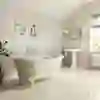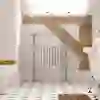Share:
When winter fast approaches, many of us will be thinking about turning our bathroom radiators back on. Yet, after a long warm spell, most radiators will have sat dormant and unused for a great deal of the year. This means there's a good chance that air has seeped into your radiator. Such trapped air will prevent a bathroom radiator from working efficiently to heat your space.
Here, The Bathroom Showroom shows how easy it is to bleed a radiator. Fortunately, this is a quick and easy task that can be done as a DIY job. More importantly, this will help ensure your bathroom radiator is winter ready and at its peak performance.
Tools You'll Need
- Radiator key: This is a small, specialised tool designed to open the bleed valve. Most hardware stores sell them.
- Bucket or container: To catch any water that comes out.
- Old towel or cloth: To protect your floor and wipe up any spills.
- Gloves (optional): To protect your hands from hot surfaces and water.

Step-by-Step Guide
- Turn off your heating system. It's crucial to make sure the central heating is off and the radiator has completely cooled down before you start. This prevents hot water from scalding you.
- Prepare the area. Place a towel on the floor and hold a container directly under the bleed valve to catch any water drips.
- Locate the bleed valve. On a bathroom radiator, the bleed valve is typically a small round or square screw located at the top on either the left or right side.
- Open the valve. Using the radiator key, slowly turn the valve anti-clockwise. You should hear a hissing sound as the trapped air begins to escape.
- Let the air escape. Wait until the hissing stops and a steady stream of water starts to drip out. This indicates all the trapped air has been released.
- Close the valve. Turn the key clockwise to close the valve. Don't overtighten it.
- Check your boiler pressure. After bleeding, the pressure in your central heating system may drop. Check the pressure gauge on your boiler and top it up if needed, following the instructions in your boiler's manual.
- Turn the heating back on. Once the pressure is correct, turn your heating back on and check that the radiator is now heating up evenly.

What Does 'Bleeding a Radiator' Mean?
Bleeding a radiator is a simple maintenance task that helps release trapped air in your heating systems. When trapped air is present, it prevents the hot water in your radiator from circulating effectively. The result is a drop in performance and noticeably colder room temperature or a long time to heat the room.
When to Bleed a Radiator
You'll know your radiator needs bleeding if you notice any of these signs:
- Cold at the top, warm at the bottom: This is the most common sign, as air rises and prevents the hot water from reaching the top of the radiator.
- Gurgling or banging noises: These sounds are often caused by air pockets moving through the system.
- Takes a long time to heat up: Trapped air can make your heating system work harder, reducing efficiency and increasing energy bills.
When Bleeding Radiators Should The Heating Be On?
You should always switch your central heating and hot water off at the boiler before bleeding your radiators. You should also ensure that the radiator you're working on is cold to the touch. By doing this, you prevent the possibility of scalding as you work, as there’s no chance of the water in the radiator heating up.
Also, by switching off beforehand, all the trapped air will rise to the top of the radiator, further helping you when bleeding it.
Bleeding Radiators Before Winter Ensures A More Comfortable Bathroom
Bleeding your home radiators should be an annual maintenance task best performed during autumn to prepare for the winter season. This should give you enough time to ensure your bathroom heating is in peak working performance and thus highlight any potential issues that may need further investigation before the cold weather kicks in.
That way, you can continue to enjoy your bathroom and relax in comfort while you save money on your bills, as your radiators can now reach the correct temperature more efficiently.
For guidance on tackling further DIY bathroom tasks, check out our Help & Advice section.